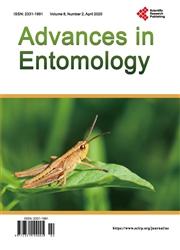The Effect of Lion’s Ear (Leonotis nepetifolia) and African Basil (Ocimum gratissimum) Plant Extracts on Two-Spotted Spider Mites (Tetranychus urticae) for Improved Yield and Quality of French Beans
引用次数: 0
Abstract
An experiment to evaluate the bio-control potential of Leonotis nepetifolia and Ocimum gratissimum plant extracts against two-spotted spider mites on French beans was conducted in the field. Five plant extract concentrations (1.5%, 3.0%, 6.0% and 12.0% w/v) were applied with water and Abamectin 0.6 ml/L as controls. Mite counts were done before and after treatment application and expressed as corrected percent efficacy. The impact of the mites on the French beans was evaluated by recording percent leaf reduction and quality and quantity by number of pods, pod length, diameter and yield. There was a dose dependent response in percent mite and leaf reduction, number of pods and yield. Treatments applied at 12% w/v indicated higher mite reduction (82.75%) for L. nepetifolia and 69.06% for O. gratissimum compared to abamectin (65.76%). The lowest percent leaf reduction of 1.71% for L. nepetifolia 0.39% for O. gratissimum and abamectin (20.46%) was also at 12% w/v. Similarly, the highest number of pod (61.00) for L. nepetifolia, 48.67 for O. gratissimum compared to 28.33 abamectin and yield (0.88 kg) for L. nepetifolia and 0.90 kg for O. gratissimum was also recorded at 12% w/v compared to 0.36 kg for abamectin. There were no significant differences in pod diameter and pod length between the extracts concentrations and abamectin. The study demonstrated the efficacy of L. nepetifolia and O. gratissimum in managing two-spotted spider mite and subsequent increase in French bean yield under field conditions.狮子耳和非洲罗勒植物提取物对荨麻叶螨的防治作用及其对法国豆产量和品质的影响
采用田间试验方法,研究了Leonotis nepetifolia和Ocimum gratissimum植物提取物对法国豆上双斑蜘蛛螨的防效。5种植物提取物浓度分别为1.5%、3.0%、6.0%和12.0% w/v,加水,以0.6 ml/L的阿维菌素为对照。螨计数在治疗应用前后进行,并表示为纠正的百分比功效。以豆荚数、豆荚长、豆荚直径、豆荚产量为指标,记录豆荚的叶减率、质量和数量,评价螨对豆荚的影响。除螨率、减叶率、荚果数和产量均呈剂量依赖性。与阿维菌素(65.76%)相比,12% w/v处理对nepetifolia L.和gratissimum O.的抑螨率分别为82.75%和69.06%。在12% w/v的情况下,山梨叶的叶片减少率最低,为1.71%,山梨叶减少率最低,为0.39%,阿维菌素减少率最低,为20.46%。同样,在12% w/v条件下,无叶扁豆的最高荚果数为61.00个,无叶扁豆的最高荚果数为48.67个,而阿维菌素的最高产量为28.33个;无叶扁豆的最高产量为0.88 kg,无叶扁豆的最高产量为0.90 kg,而阿维菌素的最高产量为0.36 kg。不同浓度的提取物对荚果直径和荚果长无显著影响。研究表明,在田间条件下,扁豆叶和扁豆叶在防治双斑蜘蛛螨和提高法国豆产量方面具有一定的效果。
本文章由计算机程序翻译,如有差异,请以英文原文为准。
求助全文
约1分钟内获得全文
求助全文

 求助内容:
求助内容: 应助结果提醒方式:
应助结果提醒方式:


